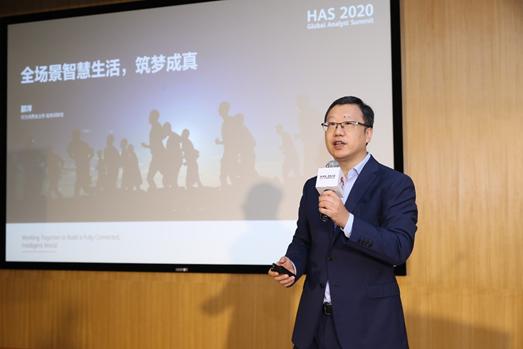
Huawei Focuses on Building Seamless AI Life as Ubiquitous Connectivity Opens New Market Opportunities
At the 2020 Huawei Analyst Summit held in Shenzhen, Huawei Consumer Business Group (CBG) met with analysts to discuss the latest industry trends, innovative technologies, and ecosystem development. The theme of this year's summit was "Seamless AI Life", and the discussion focused on the direction of future business development.
"The Internet of Everything era has opened a new trillion-dollar market and will bring new forms of services and devices to the market", said Shao Yang, Chief Strategy Officer of Huawei CBG. "Huawei Consumer Business Group is pursuing the strategic vision of Seamless AI Life. We want to revolutionize consumer experience through hardware connection, capability sharing, and content/services synchronization between 1+8+n devices."
(Picture: Shao Yang, Chief Strategy Officer of Huawei CBG)
Huawei is committed to its "1+8+N" Seamless AI Life strategy. The "+" refers to WAN and short-distance connection technologies to connect device silos and enable capability sharing among different devices used in different scenarios, bringing smart life experience to consumers. Huawei continues to invest in core technologies represented by 5G, Huawei Share, distributed OS, and Huawei Assistant, consolidates its long-term competitiveness, and continuously launches innovative products to the industry. In addition, Huawei Mobile Services allows users to synchronize content across multiple devices, revolutionizing their work, home and travel experience.
Software-powered all-scenario experience and ecosystem based on a distributed OS
The development of communications network technologies and user interaction technologies drives the continuous device evolution. Individual consumers are buying an increasing number of smart devices. However, many find that getting all these devices to cooperate with each other can be a frustrating experience.
Speaking at the summit, Wang Chenglu, President of Huawei CBG Software Engineering Department, said that the future development direction of smart devices is to connect multiple devices and enable flexible capability expansion with smartphones in the center. This poses new requirements for operating systems. Cross-device communication must be as efficient and smooth as intra-device communication. Resources and capabilities should be shared between devices on top of secure access and connection. The ecosystem should be truly open and support capability sharing with third-party devices.
(Picture: Mr. Wang Chenglu, President of Huawei CBG Software Engineering Department)
With the distributed soft bus and database, Huawei has comprehensively revolutionized the OS from the bottom-layer architecture to inter-device interaction, enabling smooth collaboration between devices, which is comparable to intra-device data access. It establishes trust relationships between people, devices, and data through distributed security technology to ensure user security and privacy in all scenarios. By opening the distributed capability, more devices can share their capabilities with each other. For example, with the multi-screen collaboration feature of EMUI 10.1, the PC camera or microphone can be used to answer an incoming call on a mobile phone. The Multi-device Control Center on the mobile phone enables smart interaction between devices, allowing you to turn on IoT devices or project the display of one device to the screen of another.
The openness of distributed capabilities will bring more opportunities to the industry. For hardware vendors, the distributed capability enables apps to invoke device capabilities more easily, which in return boosts the device usage rate. Distributed capabilities can reduce development difficulty and time costs for developers, who only need to develop one version of app for multiple devices and bring users a seamless AI life experience featuring multi-device collaboration.
Fully opening Huawei Mobile Services to build a seamless AI life
Huawei is opening its "Chipset-Device-Cloud" capabilities to developers. These capabilities include dozens of HMS Core Kits such as Account Kit, In-App Purchase Kit, Machine Learning Kit, HiAI Kit and Camera Kit. Huawei is working with developers and partners around the world to build the Huawei Mobile Services ecosystem and enrich the content and services available to Huawei users, bringing a seamless AI life to consumers in the 5G era.
Addressing attendees, Eric Tan, Vice President of Huawei CBG Consumer Cloud Service Department, said that Huawei offers market-leading quality apps, reduces the steps and time for them to search and select an app, and brings more secure and locally-appealing apps. In addition, Huawei has launched Quick App and Ability globally. Quick Apps offer installation-free and tap-to-play experience while atomic abilities are efficiently located and smartly recommended, bringing users a consistent experience across devices and use cases.
(Picture: Mr. Eric Tan, Vice President of Huawei CBG Consumer Cloud Service Department)
The company is providing corresponding integrated development environment (IDE) tools to developers, supporting one-point access for global distribution to all device types. As of March 2020, Huawei has more than 1.4 million registered developers worldwide. Developers are taking advantages of HMS Core kits such as map and analysis services. Already, more than 60,000 apps have integrated HMS Core services, a year-on-year increase of 66.7%. In the future, Huawei will open more Chipset-Device-Cloud capabilities and work with outstanding developers and partners around the world to build a seamless AI life ecosystem.


























